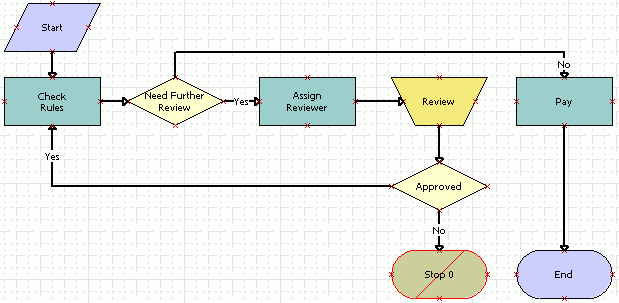Creating an Executable Workflow Process
The business analyst modeled the business process, which saved the application developer time because the developer can use the model that the analyst created as a starting point for iterative refinement. The application developer notices that, although logically it belongs in the business process model, the team must remove the submission task from the executable long-running Workflow Process because it must start the Workflow Process. The submission task must pass the ID for the expense report as an input argument. The developer decides to reuse the Object Id process property that the developer defines as an input argument to the Workflow Process. The developer communicates this refinement to the business analyst.
Next, the developer considers the Decision step that determines if further review of the expense report is required. The developer determines if it is best to call a business service that is dedicated to enforcing the review decision. The developer examines the Review task and realizes that Siebel CRM must assign it to a reviewer before Siebel CRM can instantiate it. The reviewer can use a business service step to call the Assignment Manager. This step resides immediately upstream of the review task. The following image shows the executable Workflow Process and it includes the following steps:
-
A Start step.
-
A Check Rules step.
-
A Need Further Review? decision step.
-
If Yes, then continue to step 4.
-
If No, then go to step 7.
-
-
An Assign Reviewer step.
-
A Review step.
-
An Approved decision step.
-
If Yes, then return to step 2.
-
If No, then the Workflow Process stops.
-
-
A Pay step.
-
An End step.

These revisions to the draft business model help to illustrate the differences that exist in the level of abstraction between a business process model and an executable Workflow Process. The application developer continues to refine the Workflow Process. For example, creating conditional branches, process properties, input arguments and output arguments, and then testing and deployment, until the team is ready to implement the Workflow Process in a production environment. For more information, see Siebel Business Process Framework: Workflow Guide.
Next, the business analyst identifies the context for the task.